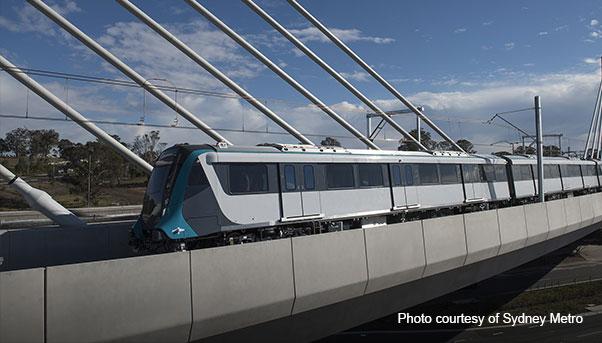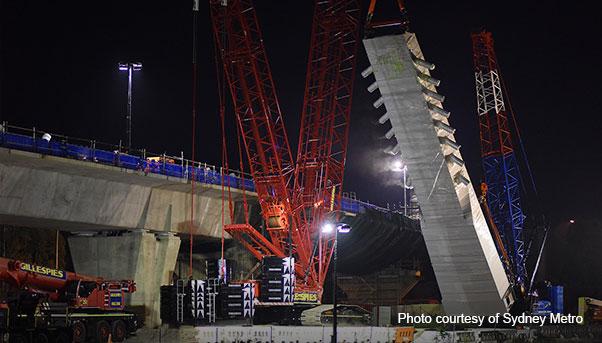
It is being called elegant.
Innovative.
Environmentally sustainable.
First of its kind in Australia.
The most visibly striking part of the biggest infrastructure project for public transport in Sydney since the Harbour Bridge nearly a century ago.
And, most of all, the year’s best – in the world.
The project in question is a 270-metre curved, cable-stayed skytrain bridge and its accompanying four-kilometre-long viaduct. Running between the suburbs of Bella Vista and Rouse Hill in the city’s northwest, it is the centrepiece of Sydney Metro Northwest, the first phase of Sydney Metro, Australia’s biggest public transport project that will expand the city’s links with the surrounding precincts.
Formally known as the Sydney Metro Northwest SVC Contract, the skytrain bridge and viaduct earned the 2018 Project of the Year award at a gala event held in New York on October 2 by Engineering News-Record (ENR), the influential U.S. trade magazine. It also received the 2018 Global Best Project award for the railway sector at the same event.
«(Sydney Metro Northwest SVC Contract, an) elegant and sustainable rail project utilizing innovative construction techniques was selected by the panel of judges and ENR editors as the Project of the Year», reads a statement on the magazine’s website.
The two awards are the latest in a series of accolades that the project has received since construction of the skytrain bridge and viaduct began in 2014. Previous acknowledgments include top ratings from the Infrastructure Sustainability Council of Australia (ISCA) for its sustainability, both in its design and the way it was built.
The SVC, or surface and viaduct civil works, was designed by SMEC and built by Salini Impregilo for Transport for NSW, the government agency that oversees the development of public transport in the state of New South Wales.
In explaining the reasons for awarding the top prize to the project, ENR highlighted the team’s success in overcoming design and construction challenges, its dedication to quality, innovation and safety, the cultural diversity of its workforce, as well as the benefits that the project is to bring to the community.
One of the most innovative features of the project’s construction was the use of a unique set of giant, mobile horizontal cranes, or launching gantries, to build the skytrain bridge and deck of the viaduct. They sat atop the piers, or columns, of the future structure to lift the precast concrete segments, or girders, into place. Although Salini Impregilo had used this system for the construction of the elevated part of a highway in Dubai, it had to modify it radically for the project in Sydney. Each gantry was 150 metres long and weighed 600 tonnes.
Salini Impregilo decided on the gantries to build the deck because it was much faster than conventional methods like scaffolding or falsework that would have involved ground machinery and a crane to put the girders into place. With each gantry hoisting 20 girders at a time, workers were able to erect a span more than twice as fast as usual. Each span comprised 10 girders, so they worked at a pace of up to two spans a week.

Skytrain, Sydney Metro Northwest
Salini Impregilo set up a concrete plant to produce the girders close to the construction site so it could exert complete control over the process. This was necessary because each girder was unique and had to be carefully cast to fit with the others along a given span. The girders for the cable-stay skytrain bridge, supported by 40-metre-tall towers, were particularly challenging due to their curved shape. There were 88 of them to be made, each weighing between 70 and 140 tonnes.
As for the concrete mix, Salini Impregilo chose additional ingredients like slag and fly ash to reduce the level of CO2that the production of the girders emitted at the facility.
The workforce of more than 4,000 was international, with people hailing from 50 countries. Despite their disparate backgrounds, they were able to keep the lost-time injury rate at a tiny 0.1 – highlighting the importance that Salini Impregilo gave to safety.
Salini Impregilo was also able to reduce the impact that its work had on the surrounding communities, leaving seven major roads and a bus lane open during the construction of the skytrain bridge and viaduct. One was the Windsor Road in Rouse Hill where 50,000 vehicles passed every day.
At a cost of AU$8.3 billion, Sydney Metro Northwest will run for a total of 36 kilometres, with 13 metro station and 4,000 commuter car spaces.
It will bring for the first time public transport service to an area where households have the highest car ownership levels in the country. The service is necessary because its population is forecast to increase by 200,000 in the coming decades, reaching more than 600,000, or twice that of Canberra, the country’s capital, according to Sydney Metro.
Population growth is a phenomenon that is occurring throughout New South Wales, which is already the most populated state in Australia at nearly 8 million. Its biggest city, Sydney, has one of the highest population densities in the state, with 391 people per square kilometer, highlighting the need for more public transport and other services. The same is occurring in other cities such as Brisbane and Melbourne, prompting their governments to launch similar infrastructure investment programmes.
The latest response by the New South Wales government to this phenomenon was to announce in June plans to invest AUD$3 billion in Sydney Metro West, the city’s next metro line, which will connect the city centre with the Greater Parramatta area. The only other line of Sydney Metro, called Sydney Metro City & Southwest, will pass under Sydney Harbour and through the city centre.
Once all of Sydney Metro is completed in 2024, there will be 31 metro stations and 66 kilometres of rail. Train service capacity for entering the city centre will increase from about 120 trains an hour to up to 200 beyond 2024 – an increase of up to 60%.

